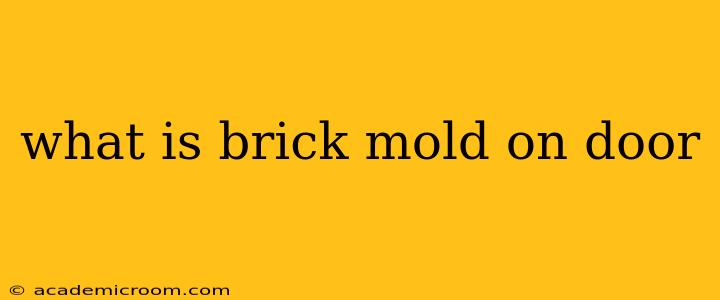Brick mold, also sometimes called brickmould, is a decorative trim piece used around exterior doors and windows. It's designed to bridge the gap between the door or window frame and the surrounding brickwork, providing a neat, finished look and protecting the building's structure. While primarily aesthetic, brick mold serves several important functional roles. This guide will explore its purpose, different styles, and considerations for choosing the right brick mold for your home.
What is the Purpose of Brick Mold?
The primary purpose of brick mold is aesthetic. It creates a clean, professional transition between the door or window frame and the brick, enhancing the overall curb appeal of a building. However, it also plays several vital functional roles:
- Weather Protection: Brick mold acts as a barrier against the elements, preventing water and moisture from seeping into the wall cavity around the door or window. This helps to prevent rot, damage to the framing, and potential mold growth.
- Structural Integrity: It provides extra support and stability to the frame, preventing shifting or damage over time.
- Insulation: By creating a tighter seal around the door or window, brick mold can contribute to improved insulation and energy efficiency.
Different Styles of Brick Mold
Brick mold comes in a wide variety of styles, materials, and finishes, allowing homeowners to customize their exterior aesthetic. Some popular styles include:
- Simple Flat Molding: This is a basic, understated style that's functional and cost-effective.
- Detailed Profiles: More elaborate options feature intricate carvings, curves, and embellishments. These can significantly add to the character of a home.
- Wood Brick Mold: Traditionally used, wood offers a natural look and can be painted or stained to match the house's exterior. However, it requires regular maintenance.
- Vinyl Brick Mold: A popular modern choice, vinyl is durable, low-maintenance, and comes in many colors and styles.
- Aluminum Brick Mold: Aluminum is lightweight, strong, and resistant to corrosion.
- Composite Brick Mold: Offers the benefits of both wood and vinyl, with a durable, low-maintenance composition that mimics the look of wood.
How is Brick Mold Installed?
Brick mold is typically installed during the construction phase of a building. However, it can be added or replaced later on. Installation involves carefully measuring and cutting the molding to fit around the door or window frame, and then securing it in place using nails, screws, or adhesive.
What Materials are Brick Mold Made Of?
The material choice for brick mold significantly impacts its durability, maintenance requirements, and aesthetic appeal. The options listed above (wood, vinyl, aluminum, composite) each present advantages and disadvantages. Consider your budget, climate, and desired aesthetic when making your choice.
How to Choose the Right Brick Mold for Your Home?
Selecting the appropriate brick mold involves considering several factors:
- Architectural Style of Your Home: The style of your house will guide your choice of brick mold. A traditional home might suit ornate wood brick mold, while a modern home might look best with sleek vinyl or aluminum.
- Budget: Costs vary greatly depending on the material and complexity of the design.
- Maintenance: Consider the amount of maintenance you are willing to undertake. Wood requires more upkeep than vinyl or aluminum.
- Climate: In harsh climates, durable materials like vinyl or aluminum might be preferable to wood.
How much does brick mold cost?
The cost of brick mold varies significantly based on the material, style, size, and installation. Expect to pay anywhere from a few dollars per linear foot for basic vinyl options to considerably more for elaborate wood or custom-designed pieces.
By understanding the purpose, styles, and installation of brick mold, you can make an informed decision when choosing the perfect option to enhance your home's exterior. Remember to consider the factors outlined above to find a solution that meets your aesthetic preferences, budget, and practical needs.
